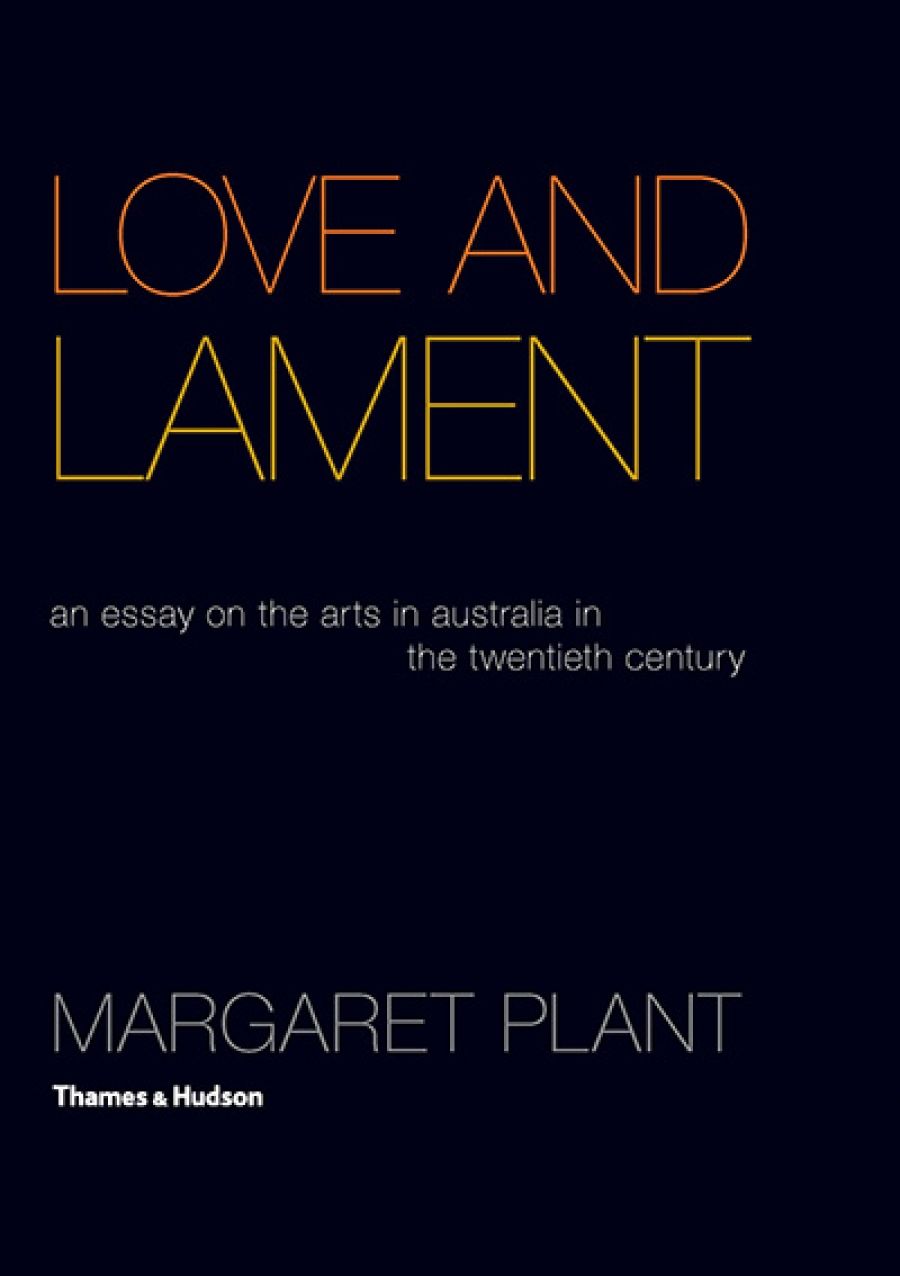
- Free Article: No
- Contents Category: Cultural Studies
- Custom Article Title: Paul Giles reviews 'Love and Lament: An essay on the arts in Australia in the twentieth century' by Margaret Plant
- Custom Highlight Text:
Love and Lament offers a bracingly revisionist and upbeat account of how the arts flourished across a broad cultural spectrum in Australia over the course of the twentieth century. Margaret Plant, an emeritus professor of the visual arts at Monash University, argues explicitly with the thesis propounded by Keith ...
- Book 1 Title: Love and Lament
- Book 1 Subtitle: An essay on the arts in Australia in the twentieth century
- Book 1 Biblio: Thames and Hudson, $60 pb, 512 pp, 9780500501238
Heterogeneity and diversity are the watchwords of this book, but the risk it always runs is superficiality, of attempting to cover too much ground too quickly. Sometimes the descriptions of major authors seem too brief and encyclopedia-like to be useful to anyone other than those seeking basic background information. Though Plant is good on Norman Lindsay and on the ‘many-voiced texture’ of Percy Grainger, her treatments of Patrick White and Les Murray, for example, are radically oversimplified. The insistence on separating out individual decades is also detrimental to her consideration of these major figures, since neither writer’s oeuvre can readily be categorised in terms of the cultural politics of any given decade.
This lends Plant’s book at times a repetitive strain, since she finds herself compelled to trace the fortunes of key figures across several decades in successive chapters. However, she cites here Graeme Turner’s critical work on ‘decadology’, and one of the virtues of Love and Lament is its implicit awareness of the advantages and disadvantages of the author’s own analytical approach. The book is particularly perceptive about situations where cross-cultural forces intersect with one another, and she writes illuminatingly about, for example, the importance of Randolph Stow’s librettos for the music of Peter Maxwell Davies. It is also open to discussions of international influences, with Plant observing how the spirit of Jean Baudrillard and postmodernism first manifested itself in Australia through a series of academic conferences held in the early 1980s. This is definitely not an isolationist cultural history, but one informed by comparative perspectives. The wide-angle lens also allows the author to take into account theoretical questions of gender, and she comments, for example, on how Vance Palmer’s critical work during the Menzies era served effectively ‘to confirm the Australian tradition of the masculine bushman’. But the individual sections on writers such as Henry Handel Richardson, Christopher Brennan, and Christina Stead are more fragmented, and Plant seems more comfortable when she can explain artists and artworks synchronically, in terms of the contemporary influences that helped to shape them, rather than diachronically, in relation to their own internal complexity and the artist’s evolution across time.
The reader might infer here a book shaped in significant ways by editorial policy, with Thames and Hudson perhaps wanting a reference work that would be accessible and useful to readers in a wide range of institutional contexts. Such demands would also help to account for the multiplicity of subheadings here, a feature that breaks up the flow of the argument and gives the book a discontinuous feel, even though these subdivisions do make it easier for readers to find particular morsels of information. It is true that many of Plant’s observations are telling, if brief, and overall the author does a remarkable job of capturing the richness and variety of Australian cultural life. She is particularly good on music, making astute comments about the significance of jazz in the 1940s and on the role played by astronomy in Richard Meale’s classical music of the 1960s. Indeed, in terms of the eclectic nature of its purview, it is hard to see how this book could have been bettered. Inevitably, given the wealth of information provided here, there are a few minor errors. The poet Robert D. FitzGerald is spelt incorrectly throughout, while the official title of Don McLean’s musical tribute to Vincent Van Gogh is ‘Vincent’, rather than, as is suggested here, ‘Starry Starry Night’.
There is no real conclusion to this book other than that the twentieth century provided ‘rich cultural offerings’, since the trajectory of this narrative is not polemic but accumulation. Nevertheless, the book is extensively documented, so that readers can consult the plentiful footnotes to chase up any particular topic that might interest them, and given the breadth of its cultural coverage Love and Lament would be an ideal acquisition for public libraries. Yet the intellectual scope of this book carries a wider resonance, in the way that it seeks not only to describe but also to justify an idiosyncratic Australian tradition. Plant cites with approbation Humphrey McQueen’s ‘brilliant study’ The Black Swan of Trespass (1979), and her own work carries a similar kind of iconoclastic charge. In its adumbration of a rich cultural field where high and low cultures intersected in manifold ways, Love and Lament provides a welcome and indeed necessary corrective to the old-fashioned idea that Australia in the twentieth century suffered from a cultural time lag. Though Plant’s book does at times suggest a packaged format, it has also been very handsomely produced and, more importantly, it encompasses a wealth of fascinating and sometimes off-beat material between its covers.


Comments powered by CComment